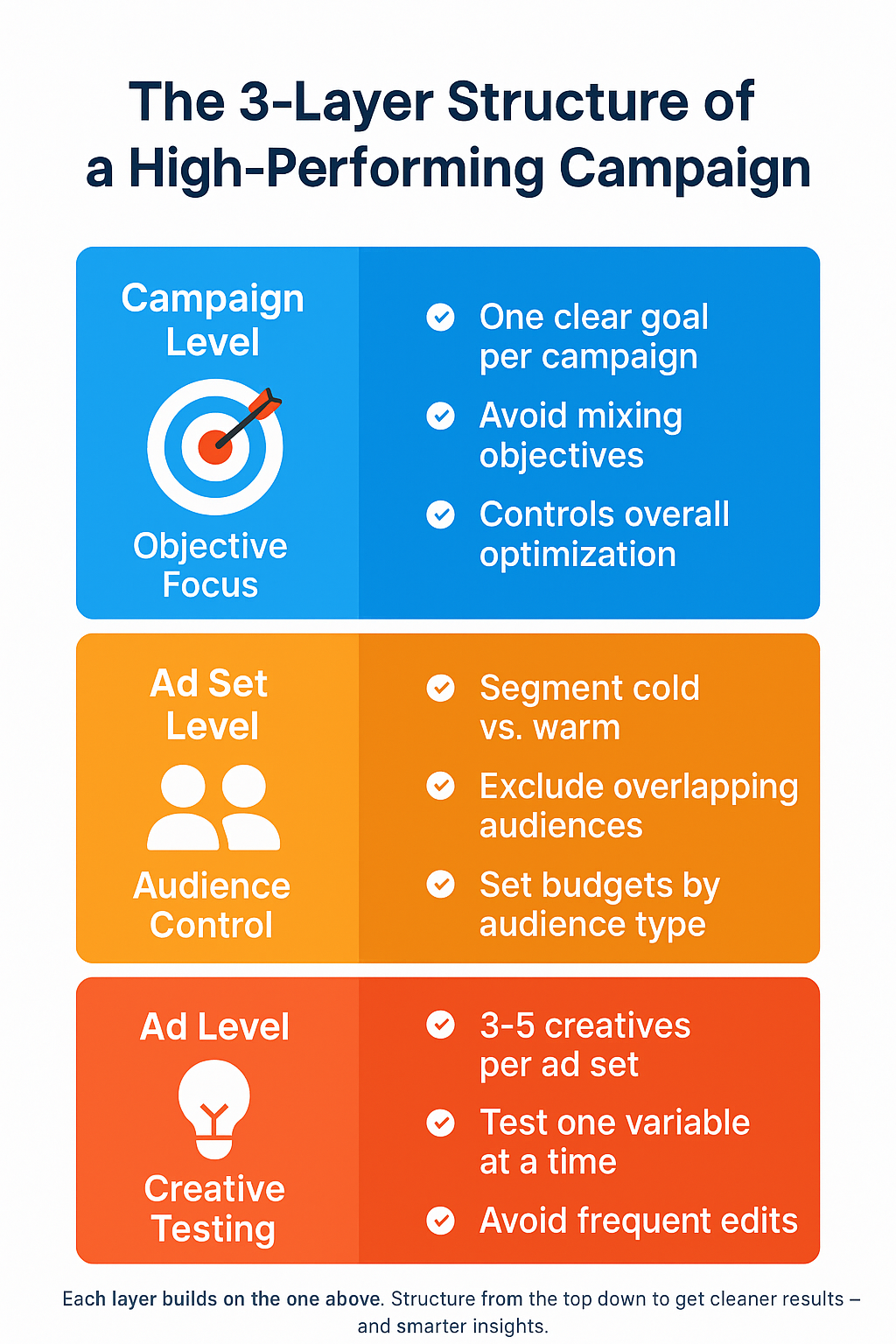If your ad results swing wildly from week to week, it’s probably not the algorithm’s fault. More often than not, unstable performance is a sign of messy campaign structure.
Your campaign structure controls how your budget flows, how data is learned, and how results are tracked. Yet many advertisers treat it like a side note instead of a foundation. Want consistency? You need a system.
Let’s break down what that system looks like, why it matters, and what to fix if your results are too unpredictable.
Why Campaign Structure Is a Bigger Deal Than You Think
A well-structured campaign doesn’t just look clean in Ads Manager. It helps Meta (or any ad platform) understand what you want to achieve and how to get you there efficiently.

Here’s what a strong structure can help you do:
-
Accelerate optimization. Clear campaign hierarchies help algorithms move through the learning phase faster.
-
Segment performance properly. When you organize campaigns by goals and audiences, it’s easier to identify which elements drive conversions.
-
Scale predictably. You can increase budgets with confidence because you understand what’s working and what isn’t.
On the flip side, poor structure leads to common issues like limited delivery, audience overlap, or unpredictable cost-per-result. Ever seen the warning “Ad set may get zero”? That usually means your setup needs refinement. Read: Why You See 'Ad Set May Get Zero' on Facebook and How to Fix It.
The Three Layers That Define Performance
Let’s look at each layer of your campaign structure — and how to get it right.

1. Campaign Level: Stick to One Objective
This is your foundation. Each campaign should have one clear, measurable goal — for example, purchases, leads, or engagement. Mixing objectives (like traffic + conversions) confuses Meta’s optimization logic and muddies your reporting.
If you’re not sure which objective suits your campaign, this guide breaks it down: Meta Ad Campaign Objectives Explained.
2. Ad Set Level: Segment Audiences Strategically
The ad set level is where targeting and budgeting come together — and where many advertisers go wrong. Your goal here isn’t to reach everyone, but to learn who responds best.
Structure your ad sets to test key audience types without overlap. For example:
-
Cold vs. warm audiences. Keep new prospects separate from people who’ve already interacted with your brand.
-
Audience exclusions. Exclude website visitors or past converters when targeting new users.
-
Granular segmentation. Split lookalikes, interests, and demographics into individual ad sets so you can evaluate performance precisely.
For more strategy around mapping audiences to your campaign structure: Mapping the Customer Journey to Facebook Campaign Structure.
3. Ad Level: Test Creatives Without Breaking Structure
The ad level is where creative testing happens — but that doesn’t mean chaos. Too many active creatives in one ad set can slow learning and confuse results.
Here’s how to structure your creative testing effectively:
-
Limit active variations. Run 3–5 ads per ad set. This allows enough data for the algorithm to learn without splitting delivery too thin.
-
Test one variable at a time. Change either the headline, image, or CTA — not all three.
-
Avoid constant edits. Frequent changes reset the learning phase and distort results.
If you want to build a clean, test-friendly structure, this will help: How to Structure Facebook Campaigns for Rapid Testing and Iteration.
The Payoff: Why Structure Drives Predictable Scaling
Once your campaign is properly structured, the benefits compound fast. You’ll be able to:
-
Identify winning combinations of audience and creative with clarity.
-
Scale budgets safely without throwing the campaign back into learning.
-
Maintain consistent CPA or ROAS over time, even when you expand targeting.
Clean structure also supports advanced strategies like using Advantage+ automation, since those systems depend on strong data signals.
When structure works, optimization stops being guesswork — and your results finally stabilize.
Common Structure Mistakes That Quietly Kill Performance
Even experienced advertisers slip into habits that undermine their campaigns. Watch out for these pitfalls:
-
Too many objectives per campaign. Each one sends different optimization signals.
-
Audience overlap. Multiple ad sets chasing the same users inflate CPMs.
-
Testing everything at once. Without control groups, you can’t pinpoint what improved performance.
-
Constant creative swaps. Every major change restarts learning and wipes performance data.
-
Stacking audiences. Interest stacking hides insights and makes testing impossible.
If you need help visualizing campaign models that actually work, this guide breaks it down: 5 Common Facebook Campaign Structures and When to Use Each One.
Final Word: Structure Isn’t Flashy — But It’s What Works
Strong creatives and smart targeting will always matter, but without structure, none of it scales consistently. A solid campaign framework gives you clarity, control, and predictability — the three things every media buyer needs.
Whether you’re running lead generation, e-commerce, or awareness ads, focus on structure first. Once your setup is clean, scaling becomes simple — because your data finally tells a clear story.
Let structure do the heavy lifting, so you can finally stop guessing and start growing.

